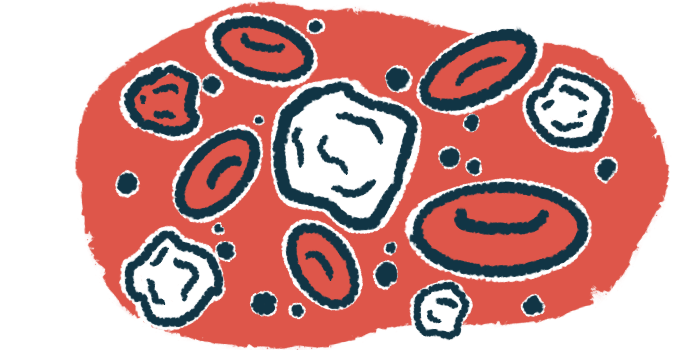Platelets stripped of some sugar molecules may help with hemophilia
In surprise finding, these blood platelets work to prevent inhibitor development

Treatment with platelets stripped of their natural sugar molecule coating helped to prevent inhibitors, or neutralizing antibodies, from forming against clotting factor VIII (FVIII) replacement therapy in a mouse model of hemophilia A, a study reported.
Platelets promote blood clotting, and they are generally thought to boost inflammation and immune responses. But in a stripped form they were found to quickly be cleared by the liver, ultimately triggering an immunosuppressive response with lower antibody levels.
“Traditional thinking of platelets is that they are pro-inflammation and pro-immunity, but we discovered, surprisingly, that they can do the opposite — they can inhibit inflammation and inhibit an immune response,” Heyu Ni, MD, PhD, the study’s senior author with St. Michael’s Hospital’s Keenan Research Centre for Biomedical Science in Toronto, said in a press release.
“This completely shifts our understanding of how platelets behave — a possible switch from foe to friend,” Ni added.
Findings suggest that treatment with stripped platelets may help to prevent the formation of inhibitors, which can limit replacement therapy efficacy, in hemophilia A and hemophilia B.
Treatment of hemophilia can be complicated with inhibitors to the clotting factor
The study, “Desialylated Platelet Clearance in the Liver is a Novel Mechanism of Systemic Immunosuppression,” was published in Research.
Platelets are small cells in the blood that are important for regulating blood clotting.
“Despite their well-recognized role in proinflammation, the anti-inflammatory/immunosuppressive role of platelets is not well explored,” the researchers wrote.
During platelet aging and in certain abnormal contexts, these cells undergo modifications that strip them of specific molecules at the end of sugar molecules at their surface. This process, called desialylation, “leads to increased trafficking and clearance of desialylated platelets (dPLTs) to the liver,” the researchers wrote. Of note, platelets are usually cleared in the spleen.
However, the effects of desialylated platelet clearance were not known until now.
While trying to better understand autoimmune diseases in which the immune system attacks the body’s own platelets, Ni and his team accidentally found that desialylated platelets, and more specifically their clearance, promoted immunosuppression.
Given that platelet terminal surface molecules were thought to prevent antibody-mediated autoimmune responses against platelets, the researchers expected that desialylation would boost those abnormal immune responses.
But they found just the opposite — administering desialylated platelets to a modified mouse model strongly reduced immune activity, with significantly lower levels of antibodies.
“These data indicate that clearance of [desialylated platelets] … may lead to an anti-inflammatory and immunosuppressive state that dampens a cocurrent immune response,” the researchers wrote.
In a series of further experiments, the researchers deduced the reason for this unexpected finding. They found that desialylated platelets mostly were cleared by resident liver immune cells, called Kupffer cells. After gobbling up the platelets, Kupffer cells would start producing anti-inflammatory molecules.
In addition, desialylated platelet clearance was associated with an increase in circulating regulatory T-cells, a type of immune cell that dampens immune responses.
Desialylated platelets seen to promote immunosuppressive responses
Study findings, overall, indicated that desialylated platelets and their clearance result in anti-inflammatory and immunosuppressive responses. Given that all aged platelets undergo desialylation, this process may work as a daily preventive mechanism against many autoimmune diseases, Ni said.
To understand the clinical implications of their findings, researchers tested whether administering desialylated platelets to a mouse model of hemophilia A could lower the production of inhibitors against FVIII replacement therapy.
Hemophilia is caused by a deficiency of clotting proteins — FVIII in hemophilia A and factor IX in hemophilia B. In both disease types, standard treatment involves replacement therapies, where a version of the deficient factor is administered to the bloodstream.
Given a reduced exposure to the missing clotting factor, the body’s immune system may recognize the replacement protein as foreign, producing inhibitors against it that can stop the replacement therapy from working.
Experiments in an inhibitor-prone mouse model of hemophilia A showed that when desialylated platelets were infused before replacement therapy, none of the mice developed inhibitors.
When desialylated platelets were administered after replacement therapy, about half of the mice developed high inhibitor levels, compared with nearly all (93%) of the mice not given the desialylated platelet infusion
This work “introduces therapeutic potential of [desialylated platelets] transfusions to promote immunosuppression or to utilize dPLTs as delivery vehicles for antigens [immune target molecules] requiring cover from immune surveillance, such as replacement FVIII in hemophilia A,” the researchers wrote.
His team’s discovery also may have implications for other autoimmune diseases and organ transplants, Ni said: “We don’t know yet the full extent of the impact, but the potential opportunity is huge.”







